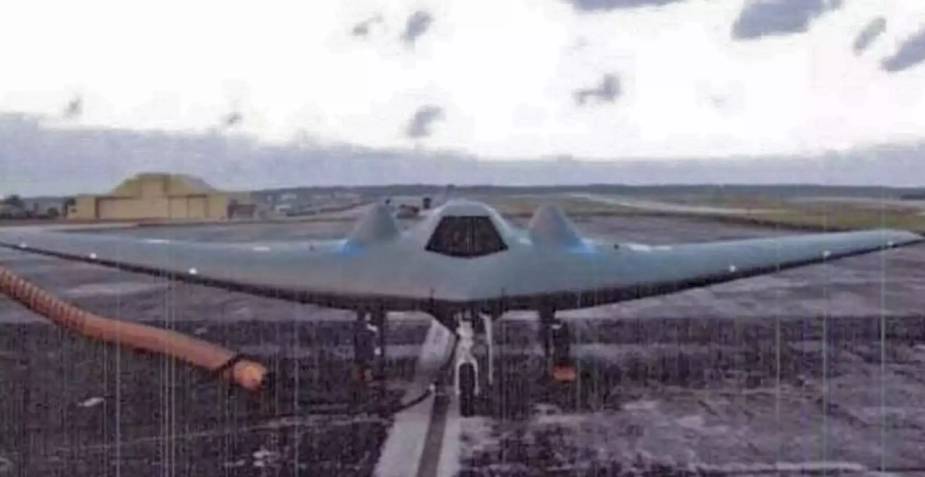Breaking news
US spy stealth drone RQ-170 Sentinel reportedly made several flights near Russia.
As reported by Laurent Lagneau in Opex360, among the secret documents illegally posted online by Jack Teixeira, a 21-year-old member of the Massachusetts Air National Guard, US spy stealth drones RQ-170 Sentinel reportedly made several flights near Russia. No additional detail is provided.
Follow Air Recognition on Google News at this link
 Undated official USAF photograph of an RQ-170 at Andersen Air Force Base in Guam (Picture source: Wikipedia)
Undated official USAF photograph of an RQ-170 at Andersen Air Force Base in Guam (Picture source: Wikipedia)
The Lockheed Martin RQ-170 Sentinel, nicknamed Wraith, is an American unmanned aerial vehicle (UAV) developed by Lockheed Martin and operated by the United States Air Force (USAF) for the Central Intelligence Agency (CIA). While the USAF has released few details on the UAV's design or capabilities, defense analysts believe that it is a stealth aircraft fitted with aerial reconnaissance equipment. Introduced in 2007, it was deployed to Afghanistan in late 2007, and to South Korea two years later, in September 2009. Some images and details of the aircraft were released after Iran captured an RQ-170 in 2011. It has a flying wing design and uses a single engine, speculated to be either a General Electric TF34 turbofan or a Garrett TFE731.
The RQ-170 is a flying wing design containing a single (as yet classified) engine, and was estimated in 2009 by Aviation Week as having a wingspan of approximately 66 feet (20 m). Its takeoff weight is estimated as being greater than the RQ-3 DarkStar's, which was 8,500 pounds (3,900 kg). The design lacks several elements common to stealth engineering, such as zigzag-edged landing gear doors and sharp leading edges, and the exhaust is not shielded by the wing. Aviation Week postulates that these elements suggest the designers have avoided "highly sensitive technologies" due to the near certainty of eventual operational loss inherent with a single-engine design and a desire to avoid the risk of compromising leading-edge technology. The publication also suggests that the medium-grey color implies a mid-altitude ceiling, unlikely to exceed 50,000 feet (15,000 m), since a higher ceiling would normally be painted darker for concealment. The postulated weight and ceiling parameters suggests the possible use of a General Electric TF34 engine, or a variant in the airframe.
On the basis of the few publicly available photographs of the RQ-170, aviation expert Bill Sweetman has assessed that the UAV is equipped with an electro-optical/infrared sensor and possibly an active electronically scanned array (AESA) radar mounted in its belly fairing. He has also speculated that the two undercarriage fairings over the UAV's wings may house datalinks and that the belly fairing could be designed for modular payloads, allowing the UAV to be used for strike missions and/or electronic warfare. The New York Times has reported that the RQ-170 is "almost certainly" equipped with communications intercept equipment as well as highly sensitive hyperspectral sensors capable of detecting very small amounts of radioactive isotopes, as well as chemicals that may indicate the existence of nuclear weapons facilities.
Following Iranian claims of downing an RQ-170 near the Afghan border in December 2011, Iranian TV showed video footage of what appears to be an advanced unmanned U.S. aircraft that most closely resembles the RQ-170 UAV. In the footage, a member of the Iranian Revolutionary Guard released the dimensions of the aircraft, including a wingspan of about 26 meters (85 ft), a height of 1.84 meters (6.0 ft), and a length of 4.5 meters (15 ft).
It is believed that between 20 and 30 RQ-170s were in service with the USAF as of 2021. At this time, the type continued to be operated by the 30th and 44th Reconnaissance Squadrons. The USAF disclosed a deployment of RQ-170s in March 2021 but did not identify where they had operated.


























